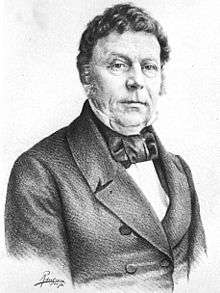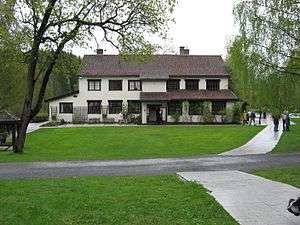Blaafarveværket
Blaafarveværket, or the Blue Colour Works, was a mining and industrial company located at Åmot in Modum in Viken county, Norway, which existed from 1776 to 1898. The works mined cobalt ore and manufactured by smelting blue cobalt glass (smalt) and cobalt blue (cobalt aluminate) pigment. It is currently a large open-air industrial museum and an art gallery; it is the largest and best preserved mine museum in Europe, and one of Norway's most visited attractions.[1]

The company was founded by King Christian VII in 1776 and was one of the few companies with lasting significance from the age of mercantilism, played an important role in Norwegian trade with Denmark, the Netherlands and the Far East and had a decisive impact on the Norwegian economy in the period around 1814. In 1822 the company was sold to the Berlin banker Wilhelm Christian Benecke and Benjamin Wegner, and their ownership lasted until 1849, a period regarded as the company's heyday and during which it became the largest industrial company of the country. The company went bankrupt in 1849 in the wake of the revolutions of 1848 and competition from synthetic ultramarine, but a greatly reduced activity continued until 1898. From 1968 Blaafarveværket has been made available to the public as a museum and art gallery. It is presented to the public like the mining company it was around 1840 during its heyday.
History

Royal ownership
Blaafarveværket was founded by King Christian VII of Denmark-Norway in 1776. Its early history is closely tied to that of the Royal Porcelain Factory in Copenhagen, as cobalt was essential for decorating porcelain. The establishment of the company represented an enormous investment on the part of the King, equivalent to the tax revenues for all of Denmark-Norway for a whole year. According to historian Ingerid Hagen, Blaafarveværket was one of the few Dano-Norwegian companies with lasting significance from the mercantilist era, played an important role in Norwegian trade with Denmark, the Netherlands and countries in Asia and had a decisive impact on the Norwegian economy in the period around 1814.[2]
The Benecke–Wegner era
During the Napoleonic Wars the royal company was pledged by the king as security for a loan, and when the state could not redeem the pledge after the Napoleonic Wars, it was taken over by the bankruptcy estate of the Swedish businessman Peter Wilhelm Berg, and sold at a public auction to a group of investors led by the prominent Berlin banker Wilhelm Christian Benecke (since ennobled as Baron Benecke). The purchase, officially in the name of a Christiania-based merchant who acted as a strawman, was orchestrated by Benecke's young associate Benjamin Wegner, who came to Norway to evaluate the company and buy it if he saw fit. After few years Benecke and Wegner formally acquired all the shares, and the company legally operated as Benecke & Wegner. Wegner also took over as director-general (CEO), a position he held from 1822 until 1849. During Benecke and Wegner's ownership, the company saw a large expansion and became the largest company in the country. It employed more than 2,000 workers, and in its peak supplied 80 percent of the world market for cobalt pigments. Wegner also instituted many important social reforms for the workers.
Reduced activity 1849–1898
The economic crisis resulting from the revolutions of 1848, in addition to the competition from the new and cheaper synthetic blue dye, ultramarine, led to the bankruptcy of Blaafarveværket in 1849. The company was sold to its most important business partner, Goodhall & Reeves of England. However, due to the economic recession, the new owners did not succeed in making the company profitable again, and in 1855 it was sold to a German company, Sächsischer Blaufarbenwerkverein. The production of pigment at the works ceased in 1857, but mining was kept up until 1898, when the company was dissolved.[3]

Museum and art gallery
In 1978, an independent foundation was established to make Blaafarveværket available to the public as an industrial museum and art gallery. Blaafarveværket has since become one of the most important art galleries in Scandinavia, and has over the years exhibited the works of many major Norwegian and foreign artists. In the summer of 2003, the gallery hosted an exhibition of the paintings of Queen Margrethe II of Denmark. In 1993, the old cobalt mines opened as a tourist attraction, and the entire area now serves as a large open-air museum.[4][5]
References
- "Ingen sommer uten Blaafarveværket," Byavisa Drammen, 21 June 2017
- Guri Kulås, "Før oljen var kobolten," Klassekampen, 31 May 2014, pp. 40–41
- "Wilhelm Christian Benecke von Gröditzberg (1779-1860)". Schlesischesammlungen.eu. Retrieved February 5, 2016.
- "Royal Modum Blaafarveværk". Blaafarveværket. Archived from the original on 2016-02-16. Retrieved February 5, 2016.
- "Blåfargeverket museum". Kulturminnesøk. Archived from the original on June 28, 2013. Retrieved February 5, 2016.
| Wikimedia Commons has media related to Blaafarveværket. |
